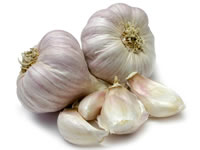Allium sativum
English: Garlic
Sanskrit/Indian: Lasuna
Russian: Чеснок

General information:
Garlic, a familiar culinary ingredient, is used as a key spice in many cuisines. Historically, it has been used as both a food and medicine in different cultures, dating back to ancient Egypt. Cultivated widely, its numerous health benefits have made it a popular herb in traditional medicine. Known to promote heart health, Garlic is now being extensively researched by modern scientists.
In his book, The Healing Power of Garlic, author Paul Bergner writes that the herb has many minerals and nutrients. He cites research conducted in 1994, when scientists reviewed previous clinical trials of Garlic and concluded that it reduces the risk of cardiovascular disease by lowering cholesterol and blood pressure.
Constituents:
While Garlic contains many active constituents, allicin is considered to be one of the primary active compounds that gives the herb its pungent odor and many of its healing properties. Allicin is released only when Garlic is crushed or chopped; finely chopped Garlic has higher amounts of allicin that whole Garlic.
Benefits:
- Garlic is traditionally used to provide relief from the common cold and cough.
- Studies suggest that Garlic helps reduce total cholesterol (TC) and serum triglyceride while raising levels of high density lipoproteins (HDL) or good cholesterol.
- The herb is also helpful in reducing blood pressure.
